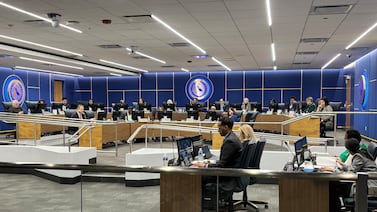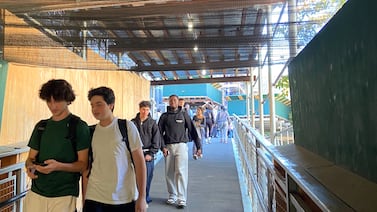Sign up for Chalkbeat Detroit’s free newsletter to keep up with the city’s public school system and Michigan education policy.
Abdullah Mansoob, 8, should have one of Detroit’s safest walks home from school.
Two blocks, a straight shot. Houses on one side, Romanowski Park on the other.
On the first day of the school year, dozens of children were outside at 3:15 p.m., shaking off the first-day jitters.
But before Abdullah could join them, he first had to negotiate a hazard.
Lonyo Street.
Semitrucks roar down Lonyo at all hours, barreling between I-94 and a sprawling complex of truck yards that sandwich this neighborhood.
The trucks could take a slightly longer route to the freeway via Wyoming Street — a few extra minutes, fewer kids, no schools. But they don’t because they don’t have to.
City Council has delayed action on a proposed truck route ordinance for years, despite long-running complaints.
“It’s a shortcut,” said Shaddad Mansoob, Abdullah’s 38-year-old father, who grew up in this neighborhood. Wyoming “is out of the way for (truck drivers). It’s like a few extra minutes, so they don’t want to do that.”
In exchange for those “few extra minutes,” hundreds of children like Abdullah face daily dangers. To play after school, he must cross Lonyo twice: once to drop off his backpack at home and again to get back to the park.
“When trucks drive, the dust goes in my eyes and face,” Abdullah said. “I have to keep looking away, turning around.”
The dust is irritating, but the bigger danger is diesel exhaust — a toxic stew of chemicals linked to respiratory illnesses, heart disease, cancer, and thousands of projected deaths nationwide this year.
“Everybody has a respiratory problem over here,” Shaddad said. “I myself have asthma. My kids do.”
“These trucks just add on to the pollution that we already have, which is not right,” he added, pointing to the freeway and nearby industrial zone.
“We pay our taxes, I feel like we should have a decent life here just like all the other neighborhoods.”
Optimism for an ordinance
None of this will come as a surprise to Detroiters. Truck traffic is a fact of life virtually everywhere in the city, from the shipping depots near Lonyo Street to warehouses on the westside and factories on the eastside.
Detroit ranks among the nation’s busiest freight hubs: Nearly 128,000 loaded containers entered the city in July alone. A city study tallied an average of 1,600 trucks going in and out of a depot near Lonyo Street every day.
The same study found that 435 trucks per day pass through the intersection — Lonyo and Arnold — that Abdullah crosses to get to school.
The semitruck parade is linked to border trade and local efforts to lure industry to the city. But residents have opposed the traffic pretty much from the start. Trucks are noisy, chew up roads, and endanger pedestrians. A semi struck and killed a man weeks ago not far from where the Mansoobs live.
City officials have promised to do something about the situation for years, but haven’t delivered.
Now the city is trying again, and its leaders insist this time will be different.
Mayor Mike Duggan’s administration is planning to ban trucks from more streets and is drafting an ordinance that could strengthen enforcement of those rules.
Sam Krassenstein, deputy director of the Department of Public Works, said Lonyo is one of several streets that will have new truck restriction signage by the end of the year. He said the city is also considering physically changing streets — by narrowing them, for instance — to discourage truck traffic.
Residents have frequently complained that truck restrictions and signage elsewhere in the city are inadequately enforced and largely ignored.
Key supporters of a truck route ordinance, including City Councilmember Gabriela Santiago-Romero, who represents Southwest Detroit, hope it will pass by the end of this year. Both mayoral candidates have said they’d support an ordinance.
Enforcement poses a thorny challenge. Ticketing trucks might seem like an obvious solution, but shipping companies could have little incentive to change their routes if the tickets go to drivers, many of whom are independent contractors. And the sheer number of trucks could overwhelm enforcement.
“Whatever ordinance we decide to go with, we want to ensure that it has a strong enforcement mechanism … that changes behavior and improves pollution or safety concerns within their neighborhood,” Sheffield said.
Trucking companies with operations near the Mansoobs’ home did not return requests for comment.
‘I wouldn’t live anywhere else’
Shaddad Mansoob says he won’t stop speaking out about truck traffic, and he certainly won’t let it push him out of the neighborhood where he grew up.
His father emigrated to the area from Yemen as a teenager, and Shaddad bought a house here as an adult. His parents live on one side of him and his sister on the other.
Gesturing down the street, he points out the homes of his cousins, aunts, uncles, and siblings. He notes proudly that many residents on his street have been there for 30 years or more. He feels lucky to raise his children in such a tight-knit, kid-friendly community. About a third of residents in his neighborhood are under the age of 18.
It’s why he refuses to leave, despite the truck traffic and pollution.
“I wouldn’t live anywhere else,” he said. “That’s why I want to make this area better for the future children growing up here, for my children.”
Koby Levin is a senior reporter for Outlier Media. You can reach him at koby@outliermedia.org





